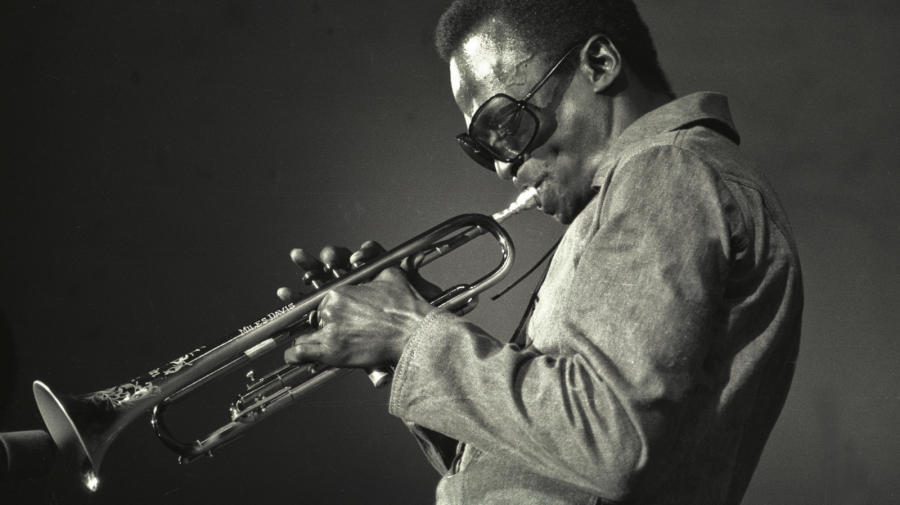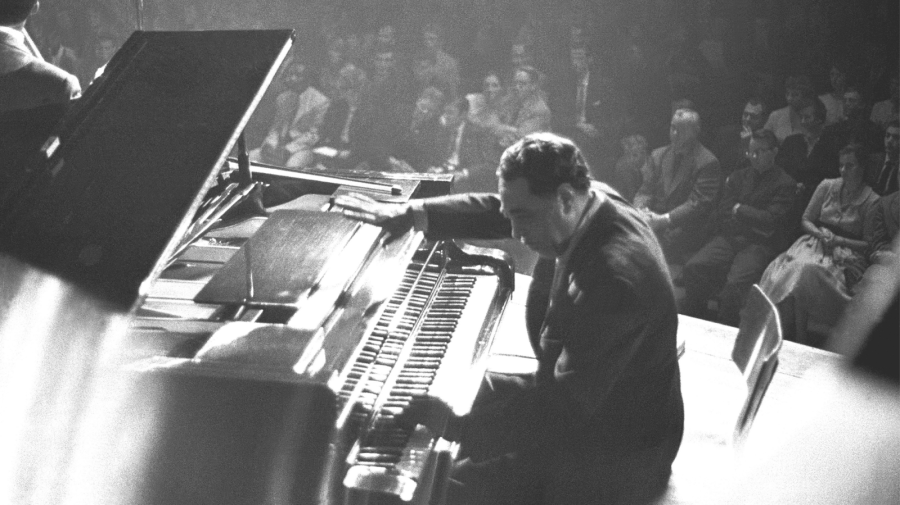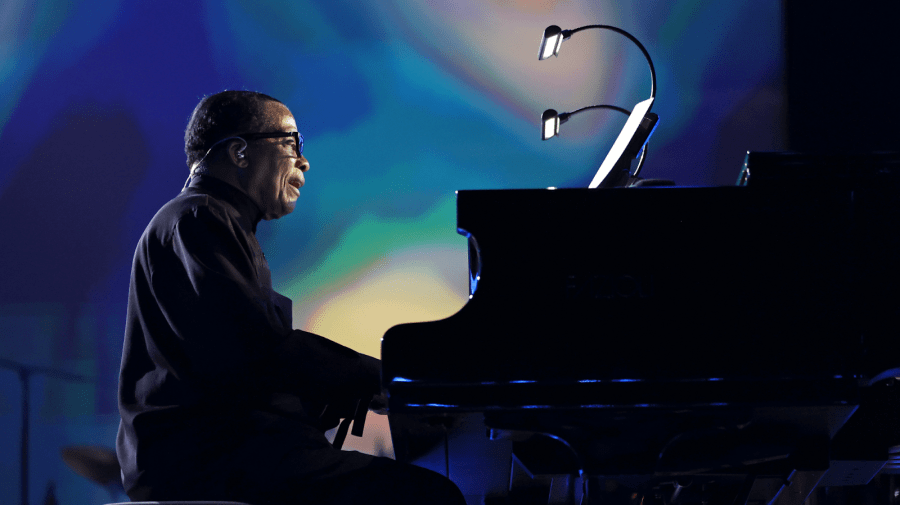We Will Be Together Again Jazz

Since 2011, April thirty has been recognized effectually the world equally International Jazz Day. Every year, millions of music aficionados participate in the celebration, which highlights the importance of the music genre — one that unites people all over the world.
And, because jazz music originated in Black American communities during a tumultuous time, International Jazz Day isn't only a time to celebrate the music itself. Instead, it's as well a time to reflect on the ways fine art grants the states freedom of expression — likewise as the ways in which the musical genre, and its greatest artists, shaped American culture at large.
From works by Louis Armstrong to those of Miles Davis, nosotros've selected viii exceptional albums that not just define the genre of jazz, only molded the musical mural of the 20th century. Whether y'all're a long-fourth dimension jazz enthusiast, practicing musician, or a new fan of the genre, you'll find a lot to love on these must-listen albums.
Kind of Blue by Miles Davis
The first spot on this listing can't be dedicated to anybody just Miles Davis — one of the about successful and influential jazz artists in history. Out of 61 studio albums recorded during Davis' fifty-twelvemonth-long career, Kind of Blue was a 1-of-a-kind breakthrough that critics deemed the greatest jazz album ever made.
Since its release in 1959, the album has sold more than than v million copies, and, despite the tearing competition, information technology's still regarded as a masterpiece of mod music. In 2002, Kind of Blue was i of the 50 recordings added to the National Recording Registry, a list of culturally and historically significant sound recordings curated by the U.S. Library of Congress.
The studio anthology A Love Supreme represents Coltrane's deep faith in God, and critics recognized information technology every bit a work of profound spirituality. All four parts of the album were recorded in one session; a calendar month later, in January 1965, the composition that redefined post-war jazz came to the low-cal.
The unique concept, along with the tracks' meditative nature, made A Love Supreme Coltrane's greatest work, acknowledged album and one of the most-praised jazz records of all fourth dimension.

Mingus Ah Um past Charles Mingus
Recorded in 1959, Mingus Ah Um thankfully wasn't overshadowed by masterpieces Time Out and Kind of Blueish, despite being released the same twelvemonth. Instead, it became ane of the best-known Mingus albums to engagement. Many of the tracks paid tribute to other jazz musicians: "Open Letter to Knuckles" was dedicated to Duke Ellington, while "Goodbye Pork Pie Lid," referred to saxophonist Lester Young, who died just before the album came out.
Impressively, Mingus Ah Um belongs to Rolling Stone's list of the Elevation 500 Albums of All Time. That's right — summit albums, regardless of genre. In 2003, information technology besides became part of the National Recording Registry.
Ellington at Newport past Duke Ellington
Ellington at Newport is a live jazz album that was released by Columbia Records in 1956. The tracks were recorded during Duke Ellington's concert at the Newport Jazz Festival but a few weeks before. Fortunately, the concert was met with great success and helped Ellington regain a foothold later a period of declining popularity.
However, 40 years since the anthology hit the market, a tape constitute in Voice of America's annal revealed that only twoscore% of the anthology recordings had come from the alive concert; the rest of the album consisted of studio recordings. All the same, Ellington is a jazz icon — and a bona fide music legend who easily tops any list.

Maiden Voyage by Herbie Hancock
Herbie Hancock, a one-time fellow member of the Miles Davis Quintet, was only 24 years old when he released his fifth anthology, Maiden Voyage. With it, Hancock aimed to create a unique concept that would evoke a marine atmosphere and ocean life.
Due to their uniqueness, tracks "Maiden Voyage" and "The Eye of the Hurricane" have get jazz standards, and are widely performed by jazz musicians today. In a 2011 interview, Hancock stated that out of 41 studio albums, Maiden Voyage remains his favorite.
The Shape of Jazz to Come by Ornette Coleman
The Shape of Jazz to Come, the third album written by Ornette Coleman, was met with mixed reactions upon its release in 1959. While some critics praised Ornette's unconventional arroyo to jazz composition, i of the nigh influential jazz figures, Miles Davis, remained unimpressed by Ornette's anthology.
Regardless of the initial reactions, The Shape of Jazz to Come has since institute its place in the jazz earth, even earning a coveted spot on Rolling Stone'southward list of the 500 Greatest Albums of All Time. Moreover, its importance was reiterated in 2012 when the U.S. Library of Congress added the album to the National Recording Registry.

Porgy and Bess by Ella Fitzgerald and Louis Armstrong
In 1959, Ella Fitzgerald, often chosen the "Queen of Jazz", and Louis Armstrong, i of the well-nigh influential jazz figures of all fourth dimension, met to record their third and final studio album. The recording contains a selection of songs from George Gershwin'southward opera Porgy and Bess and remains the well-nigh successful jazz rendition of an English-language opera.
The most notable song off this album, "Summer", was written past Gershwin in 1934, and it's ane out of five tracks that features both Fitzgerald and Armstrong. For its historical importance, the Porgy and Bess album was awarded a Grammy Hall of Fame Award in 2001.
Time Out by David Brubeck Quartet
This list wouldn't exist complete without Fourth dimension Out, a studio anthology composed by David Brubeck. Released in 1959, it became the starting time jazz recording to sell one million copies. In 2005, the U.S. Library of Congress decided to preserve the album in its National Recording Registry as a style of praising both its cultural and historical significance.
"Take Five", the most popular track from this anthology, was ironically the only song David Brubeck hadn't written himself. Its author, Paul Desmond, composed this slice as the Time Out promotional unmarried, and it later became the all-time-selling jazz unmarried of all fourth dimension.
richardsonvould1966.blogspot.com
Source: https://www.ask.com/entertainment/albums-celebrate-international-jazz-day?utm_content=params%3Ao%3D740004%26ad%3DdirN%26qo%3DserpIndex
0 Response to "We Will Be Together Again Jazz"
Post a Comment